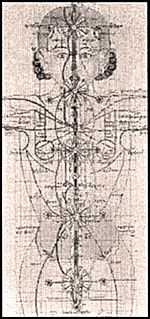Trul khor
| Trul khor | |||||
| Tibetan name | |||||
|---|---|---|---|---|---|
| Tibetan | རྩ་རླུང་འཁྲུལ་འཁོར་ | ||||
| Literal meaning | magical movement instrument, channels and inner breath currents | ||||
| |||||
Tsa lung[1] Trul khor (lit. "magical movement instrument, channels and inner breath currents") known for brevity as Trul khor (lit. "magical instrument" or "magic circle;" Sanskrit: adhisāra[2]) is a Vajrayana discipline which includes pranayama and body postures (asanas). From the perspective of Dzogchen, the mind is merely vāyu in the body. Thus working with vāyu and the body is paramount, while meditation on the other hand is considered contrived and conceptual. Chögyal Namkhai Norbu, a prominent exponent of Trul khor, prefers to use the Sanskrit equivalent term, Yantra Yoga, when writing in English. Trul khor derives from the instructions of the Indian Mahasiddhas who founded Vajrayana.

Trul khor traditionally consists of 108 movements, including bodily movements (or dynamic asana), incantations (or mantra), pranayama and visualizations. The flow or vinyasa (Sanskrit) of movements are enlikened to beads on a mala. Trul khor body postures (asanas) are depicted on the walls of the Dalai Lama's summer temple of Lukhang.
Lung
rlung (Wylie) is equivalent to the Sanskrit vāyu.
English discourse
Namkhai Norbu et al. (2000, revised)[3] opened the English discourse on Trul Khor with his treatise on Yantra Yoga, essentially a commentary on a practical yoga manual by Vairotsana, 'phrul 'khor nyi zla kha sbyor gyi dgongs 'grel dri med nor bu'i me long (Wylie).
Namkhai Norbu tilled the ground for the dissemination of Yantra Yoga through his practical teaching and esoteric transmission of this discipline within the International Dzogchen Community which he founded post 1975 from its seat in Italy, Merigar. Chaoul (2006) has opened the discourse of Bon traditions of Trul Khor into Western scholarship in English with his thesis from Rice University.[4] In his work, Chaoul makes reference to a commentary by the famed Bonpo Dzogchen master, Shardza Tashi Gyaltsen, byang zab nam mkha' mdzod chen las snyan rgyud rtsa rlung 'phrul 'khor (Wylie).
Tenzin Wangyal's text Awakening the Sacred Body presents some of the basic practices of trul khor according to the Tibetan Bon tradition.[5]
Primary texts
- Tibetan: འཕྲུལ་འཁོར་ཉི་ཟླ་ཁ་སྦྱོར་གྱི་དགོངས་འགྲེལ་དྲི་མེད་ནོར་བུའི་མེ་ལོང, Wylie: 'phrul 'khor nyi zla kha sbyor gyi dgongs 'grel dri med nor bu'i me long
- Shardza Tashi Gyaltsen: byang zab nam mkha' mdzod chen las snyan rgyud rtsa rlung 'phrul 'khor
See also
- Desi Sangye Gyatso
- Six yogas of Naropa
- Vairotsana
- Padmasambhava
Notes
- ↑ "Lung" is the Tibetan term for vayu.
- ↑ A Spacious Path to Freedom: Practical Instructions on the Union of Mahamudra and Atiyoga by Karme Chagme, Gyatrul Rinpoche and B. Alan Wallace. Snow Lion Publications: 1998 1559390719 pg 69
- ↑ Norbu, Chögyal Namkhai (2000). Revision: Laura Evangelisti. Translation: Des Barry, Nina Robinson, Liz Granger, Carol Chaney. Yantra Yoga Manual. Italy, Shang Shung Edizioni.
- ↑ Chaoul, Alejandro (2006). Magical movements ('phrul 'khor): ancient yogic practices in the Bon religion and contemporary medical perspectives. Rice University. p. 52. Retrieved 7 March 2011.
- ↑ Tenzin Wangyal Rinpoche 2011.
References
- Chaoul-Reich, Alejandro. Spinning the Magical Wheel in Snow Lion Magazine. Snow Lion Publications. Retrieved 1 December 2006.
- Chaoul-Reich, Alejandro. Tibetan Yoga from the Bon Tradition in Snow Lion Magazine. Snow Lion Publications.
- Lipson, Elaine. Into the Mystic in Yoga Journal.
- Norbu, Chögyal Namkhai (2000). Revision: Laura Evangelisti. Translation: Des Barry, Nina Robinson, Liz Granger, Carol Chaney. Yantra Yoga Manual. Italy, Shang Shung Edizioni. (This booklet is published for those who have received the transmission of these practices from Chögyal Namkhai Norbu Rinpoche.)
- Trulkhor: The Magical Movement of Tibet by M. Alejandro Chaoul
- Yogic practices in the Bon tradition by M Alejandro Chaoul
- Ancient drawing from the Blue Beryl by Sangye Gyamtso (1653-1705)
- Lipman, Kennard (1987).'The Dynamic Yoga of Tibet: combining asanas, breathing exercises, and flowing movements, Yantra Yoga aims to return us to our "natural state".' Cited in: Yoga Journal, May 1987, No. 74. Active Interest Media. ISSN 0191-0965. Source: (accessed: Friday April 9, 2010) p. 46-49
- Tenzin Wangyal Rinpoche (2011). Awakening the Sacred Body. Hay House. ISBN 1-4019-2871-4.
Further reading
- Chogyal Namkhai Norbu, Trans. by Adriano Clemente. Yantra Yoga Snow Lion Publications.
- Chang, Garma C. C.: Teachings of Tibetan Yoga/an Introduction to the Spiritual, Mental, and Physical Exercises of the Tibetan Religion, Publisher: Kensington Pub Corp, Published: 1 October 1993, ISBN 978-0-8065-1453-6
External links
- Ligmincha introduction
- Chaoul, M. Alejandro (2003). Yogic practices (rtsarlung ’phr ul ’khor) in the Bon tradition and possible applications as a CIM (complementary and integrative medicine) therapy. Presented at the Tenth Seminar in 2003 for the International Association for Tibetan Studies.
- Yantra Yoga The website dedicated to Yantra Yoga.
| |||||||||||||||||